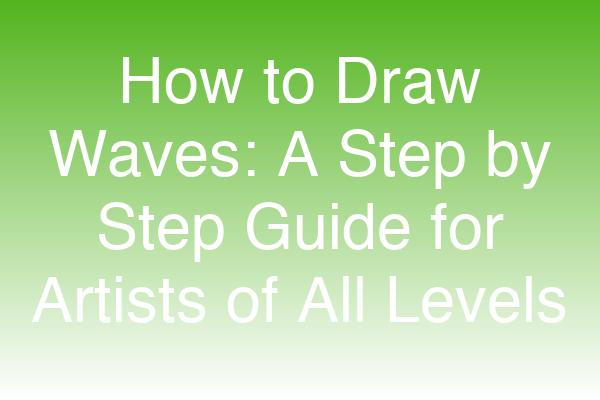
Categories: Art Techniques, Drawing Tutorials, Ocean Art
Tags: how to draw waves, drawing waves, ocean drawing, art techniques, wave illustration, beginner drawing tips, watercolor waves
Introduction
Drawing waves can be a mesmerizing experience, capturing the beauty and movement of the ocean. Whether you're a beginner or an experienced artist, understanding how to draw waves can enhance your artistic repertoire. In this guide, we will explore various techniques, tips, and tricks to help you create stunning wave illustrations that evoke the power and tranquility of the sea. Let’s dive in!
Understanding the Anatomy of Waves
Before we start drawing, it’s essential to understand the basic structure of waves. Waves are formed by wind blowing across the surface of the water, creating ripples that grow into larger waves. Here are some key components to consider:
- Crest: The highest point of the wave.
- Trough: The lowest point between two waves.
- Wave Height: The distance between the crest and trough.
- Wave Length: The distance between two consecutive crests or troughs.
Table: Wave Anatomy
| Component | Description |
|---|---|
| Crest | The peak of the wave |
| Trough | The lowest point of the wave |
| Wave Height | Distance from crest to trough |
| Wave Length | Distance between two crests or troughs |
Step-by-Step Guide on How to Draw Waves
Step 1: Gather Your Materials
Before you start, make sure you have the following materials:
- Sketching paper
- Pencils (HB and 2B)
- Eraser
- Watercolor paints or colored pencils (optional)
- Reference images of waves
Step 2: Sketch the Basic Shape
- Draw the Horizon Line: Start by drawing a horizontal line across your paper to represent the horizon.
- Outline the Wave: Lightly sketch a series of curved lines to represent the wave's shape. Use smooth, flowing curves to mimic the natural movement of water.
Step 3: Add Details
- Define the Crest and Trough: Emphasize the crest by adding a thicker line at the top of the wave. Draw the trough with a gentle curve.
- Texture: Add texture by drawing smaller, wavy lines along the body of the wave. This will give the illusion of movement and depth.
Step 4: Shading and Color
- Shading: Use your 2B pencil to add shading to the trough and the underside of the wave. This will create contrast and depth.
- Coloring (Optional): If you’re using watercolors, apply a light wash of blue and green to represent the water. Use white for highlights on the crest.
Techniques for Realistic Waves
To create more realistic waves, consider the following techniques:
- Use Reference Images: Study photographs of waves to understand their shapes and colors.
- Experiment with Brush Strokes: If using paint, try different brush strokes to create texture.
- Layering: Build layers of color to add depth and dimension to your waves.
Expert Insights
"Understanding the physics of waves can greatly enhance your ability to draw them. Pay attention to how light interacts with water to create reflections and shadows." – Jane Doe, Professional Artist
"Practice makes perfect. Don’t be afraid to make mistakes; each wave you draw will teach you something new." – John Smith, Art Instructor
Common Mistakes to Avoid
- Overcomplicating the Shapes: Keep your initial sketches simple.
- Ignoring Light and Shadow: Proper shading can make a significant difference in realism.
- Rushing the Process: Take your time to observe and replicate the nuances of waves.
Visual Content Suggestions
- Images: Include step-by-step images showing the progression of drawing waves.
- Infographics: Create an infographic illustrating the anatomy of waves.
- Videos: Consider embedding a video tutorial demonstrating wave drawing techniques.
Conclusion
Learning how to draw waves is not only a valuable skill for artists but also a way to connect with the beauty of nature. By understanding the anatomy of waves and practicing various techniques, you can create stunning ocean scenes that capture the essence of the sea. So grab your pencils and start sketching!
Call-to-Action
Ready to take your wave drawing skills to the next level? Download our free wave drawing cheat sheet and start creating breathtaking ocean art today!
Social Media Snippet: 🌊 Want to learn how to draw waves? Check out our step-by-step guide filled with tips, techniques, and expert insights! #Art #Drawing #Waves
Suggested Internal Links:
Suggested External Links:
FAQs
Q1: What materials do I need to draw waves?
A1: You’ll need sketching paper, pencils, an eraser, and optionally, watercolor paints or colored pencils.
Q2: How can I make my wave drawings look more realistic?
A2: Use reference images, pay attention to light and shadow, and practice different brush strokes for texture.
Q3: Is it necessary to color my wave drawings?
A3: Coloring is optional, but it can enhance the visual appeal of your artwork.
Q4: How can I improve my drawing skills?
A4: Regular practice, studying reference images, and seeking feedback from other artists can help improve your skills.
Q5: What are some common mistakes when drawing waves?
A5: Common mistakes include overcomplicating shapes, ignoring light and shadow, and rushing the drawing process.
By following this comprehensive guide, you’ll be well on your way to mastering the art of drawing waves. Happy drawing!